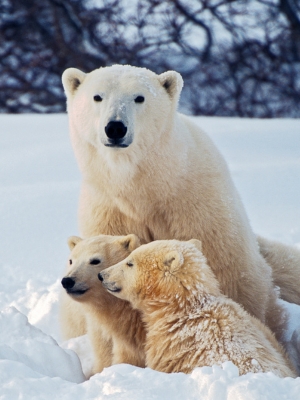This year, October 20-26 is National Wolf Awareness Week. During this important week, we uncover the misinformation spread about wolves and advocate for their continued protection in the United States.
The History of Wolves in the Unites States
There are two widely recognized wolf species found in the U.S.: the gray wolf and the red wolf. The red wolf is the rarest large carnivore in the U.S. and is Critically Endangered. Over the last century, all wolves in the U.S. have had a complicated relationship with humans that has negatively impacted their conservation status. The demonization and killing of wolves began in the early 1900s due to widespread misinformation about their danger to humans and livestock.
Avid hunters quickly reduced their numbers across the country by hundreds of thousands. In 1973, the federal government designated wolves as the most endangered species in the U.S., and in 1974, wolves were listed as Endangered and given legal protection as a result. These protections included a ban on harming or capturing them. Federal agencies were also required to ensure their actions didn’t threaten wolves’ critical habitats. This listing allowed wolves to begin to recover.
Despite decades of fighting to improve the conservation status of wolves in the wild following the 1970s, in 2011, Congress delisted gray wolves in Idaho and Montana. This was the first time a legislative body had delisted a species instead of an environmental agency. In 2019, the Trump administration delisted gray wolves nationwide, stripping the animals of all protection throughout the country.
The removal of wolves’ protection swiftly reignited harmful activities towards them, including largely unregulated and cruel hunting practices like the use of snares, baiting, hounding, bounties, and shooting from an aircraft. Immediately following the delisting, over 200 wolves were killed in just 60 hours in one of the first hunts after protections were removed. Today, only approximately 15,000 gray wolves and just dozens of red wolves remain in the wild in the U.S.
In 2022, a federal judge found that the 2019 delisting was not supported by science and reversed the decision. This did not include wolves in the Northern Rocky Mountain states, whose management is governed by a different set of rules. In February 2024, the U.S. Fish and Wildlife Service (USFWS) announced that they would support a long-term approach to the conservation of gray wolves and would develop the first National Recovery Plan under the Endangered Species Act (ESA) for gray wolves in the lower 48 states. Unfortunately, the USFWS did not make any changes to the legal status of gray wolves in the U.S. at this time. We continue to call on the USFWS to reinstate their federal protection of wolves to prevent any further unnecessary losses of these important animals.
As Keystone Species, Wolves Benefit their Ecosystems
Wolves are important because they are considered a keystone species, whose presence significantly impacts the function of the ecosystem. Wolves do this by regulating herbivore populations like deer and elk, which helps prevent overgrazing and promote vegetation growth and diversity. The presence of wolves also positively impacts the landscape; wolf predation on other animals can influence how they move across the landscape, which can affect vegetation patterns and river flow dynamics. The carcasses of wolves’ prey also provide food for scavengers and other carnivores, contributing to nutrient cycling within the ecosystem.
We know the negative impacts that having less (or no) wolves can have on the environment primarily because of Yellowstone National Park. At the height of wolf hunting in the 1900s, almost all wolves were eradicated from areas in and around the park. Seventy years without wolves drastically changed Yellowstone. Without predation pressure from wolves, elks became overpopulated and overgrazed the land and trees. With less vegetation, songbirds began to decline. Without trees, beavers could no longer build their dams, and streams began to erode and degrade the environment. Without beaver’s dams and the shade from trees and plants, water temperatures became too high for cold water fish. Therefore, wolves are essential to the functioning of the ecosystems in which they live, and their absence directly impacts the ability of other animals to survive and thrive in the places they call home.
Working to Protect Wolves During National Wolf Awareness Week and Every Week
Born Free USA works with partners to increase the essential protection of wolves and other wildlife via the strengthening of legislation like the Endangered Species Act, as well as fighting for the introduction of new laws to protect wild animals in their natural habitat from harms like trophy hunting, killing contests, and trapping. Please read and share our work to help us honor National Wolf Awareness Week!
You can learn more about our work and help us advocate for the animals that need us most here. You can also help protect wolves from hunting, trapping, and human encroachment on their lands by symbolically adopting a wolf today!

 Dear Reader,
Dear Reader,